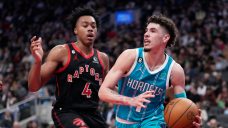Here are five takeaways from the Toronto Raptors’ 124-114 win over the Charlotte Hornets on Thursday.
1. Pascal Siakam dominated from start to end, finishing with a hyper-efficient 35 points on 11-of-13 shooting.
Steve Clifford tried a variety of matchups, from a burly wing in P.J. Washington, to longer athletes J.T. Thor and Jaden McDaniels, and even a point guard in Dennis Smith Jr. in the fourth quarter. Nobody could check Siakam, who scored at all three levels, including a perfect 3-for-3 from deep, a handful of midrange jumpers, and a smattering of drives to the rim.
Charlotte resorted to hard-trapping Siakam at the halfway line from the end of the third quarter onward, willingly conceding the 4-on-3 advantage behind the play instead of allowing any chance for Siakam to operate. That’s the only reason Siakam didn’t finish with 40-plus, and it’s the ultimate sign of respect from the opponent.
Siakam unselfishly turned himself into a decoy in the fourth as he stretched the Hornets into committing two defenders above the arc before feeding his teammates on the roll to then set up the hockey assist for corner threes.
2. Outside of playing through Siakam, the Raptors were also able to generate easy looks through the pick-and-roll.
The combination of Fred VanVleet and Scottie Barnes was especially effective, as VanVleet set up seven of Barnes’ eight makes, including six rolls to the rim. Barnes at centre has created unique advantages on offence, and the Raptors have largely attacked the gaps by giving the ball to Barnes to distribute in the middle of the floor.
The other easy way to attack was to have Barnes set a firm screen, which got VanVleet downhill with the Hornets opting to step up to deny the open pull-up jumper, which in turn freed the feed to Barnes on the roll to the rim.
After profiting easily from this action in the first half, the Hornets were less aggressive in stepping up to VanVleet, which left a smaller window for the pass to Barnes, but VanVleet made three clever disguised feeds to Barnes, who twice was able to catch it high and finish off the glass without ever bringing the ball down.
Opposing centres keep giving Barnes space to shoot, and while the shot still isn’t something he’s willing to take, the Raptors have found multiple ways to beat the scheme.
3. The second unit just needs to be a net neutral in order to be successful.
Toronto’s reserves opened up a lead in their first shift, which largely came against a comically bad spell for Charlotte, but was shaky in holding the lead in the fourth, which pressed coach Nick Nurse into bringing back his starters for the last eight minutes.
Christian Koloko picking up three fouls in four minutes to start the game really threw things into flux, given that the rookie had been quietly propping up the bench over this three-game win streak, but Precious Achiuwa continues to build momentum coming off injury and his contributions as a scorer have been positive despite some shaky decision-making.
Nurse augmented his rotation by also adding Barnes to guide the second unit instead of relying only on Gary Trent Jr., which created easier looks in the half-court with Barnes directing traffic.
The missing piece is Malachi Flynn, who had yet another scoreless outing, but the bigger issue was that he only took one attempt. Flynn’s discretion is understandable since he is shooting 4-for-30 in his last eight games, but he needs to provide catch-and-shoot threes with the reserves to boost the scoring.
Nurse continues to show faith in Flynn, but Jeff Dowtin should get a turn if Flynn is losing his confidence.
4. Toronto’s defence was better than in its first meeting on Tuesday.
Charlotte still shot the lights out on broken plays, as both LaMelo Ball and Terry Rozier had a knack for making heavily contested shots, but the overall approach was strong. Specifically, the Raptors did a better job of rotating on defence, particularly against Charlotte’s potent guards.
Even though they were allowed to get downhill too easily at the point of attack, the Raptors were able to rotate to cut off their drives to the basket, which forced them into 22 turnovers.
Nurse was all right with leaving McDaniels and Mason Plumlee momentarily open for three or even in the paint, trusting that they wouldn’t be able to make plays even when given the advantage.
Plumlee had a pair of turnovers down the stretch forcing kick-out passes that weren’t actually open, while Ball and Rozier also forced fading threes from the corner that clanked off the side of the backboard in search of scoring that wasn’t there from their teammates.
5. These two games were reminders that tanking is not for the faint-hearted.
Charlotte is not just bad — they’re almost comically inept. After allowing 38 points in the first frame, the Hornets immediately opened the second quarter by losing track of Barnes, who crept behind the entire defence for a dunk.
Clifford called a snap timeout despite having just regrouped a minute earlier to arrange his team, and what was the Hornets’ response? Five straight turnovers on offence, while also committing goaltending, fouling a bad three-point shooter on a silly closeout, and allowing yet another back cut for an and-one.
To be effective at tanking is to be that ineffective at the basics of basketball for entire months on end. Toronto has underperformed, but there are more levels to plunge to truly be competitive for the top picks.










































COMMENTS
When submitting content, please abide by our submission guidelines, and avoid posting profanity, personal attacks or harassment. Should you violate our submissions guidelines, we reserve the right to remove your comments and block your account. Sportsnet reserves the right to close a story’s comment section at any time.